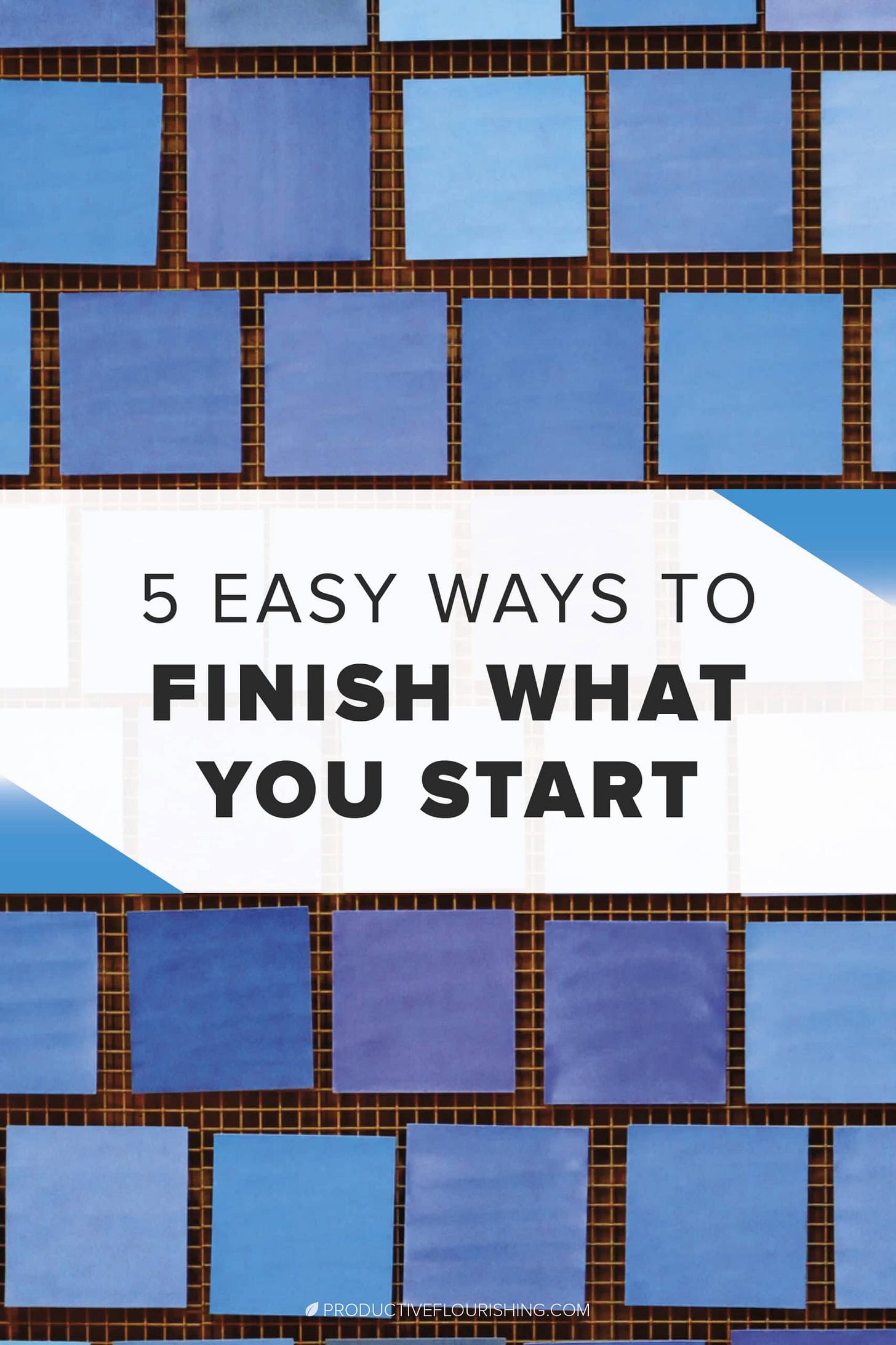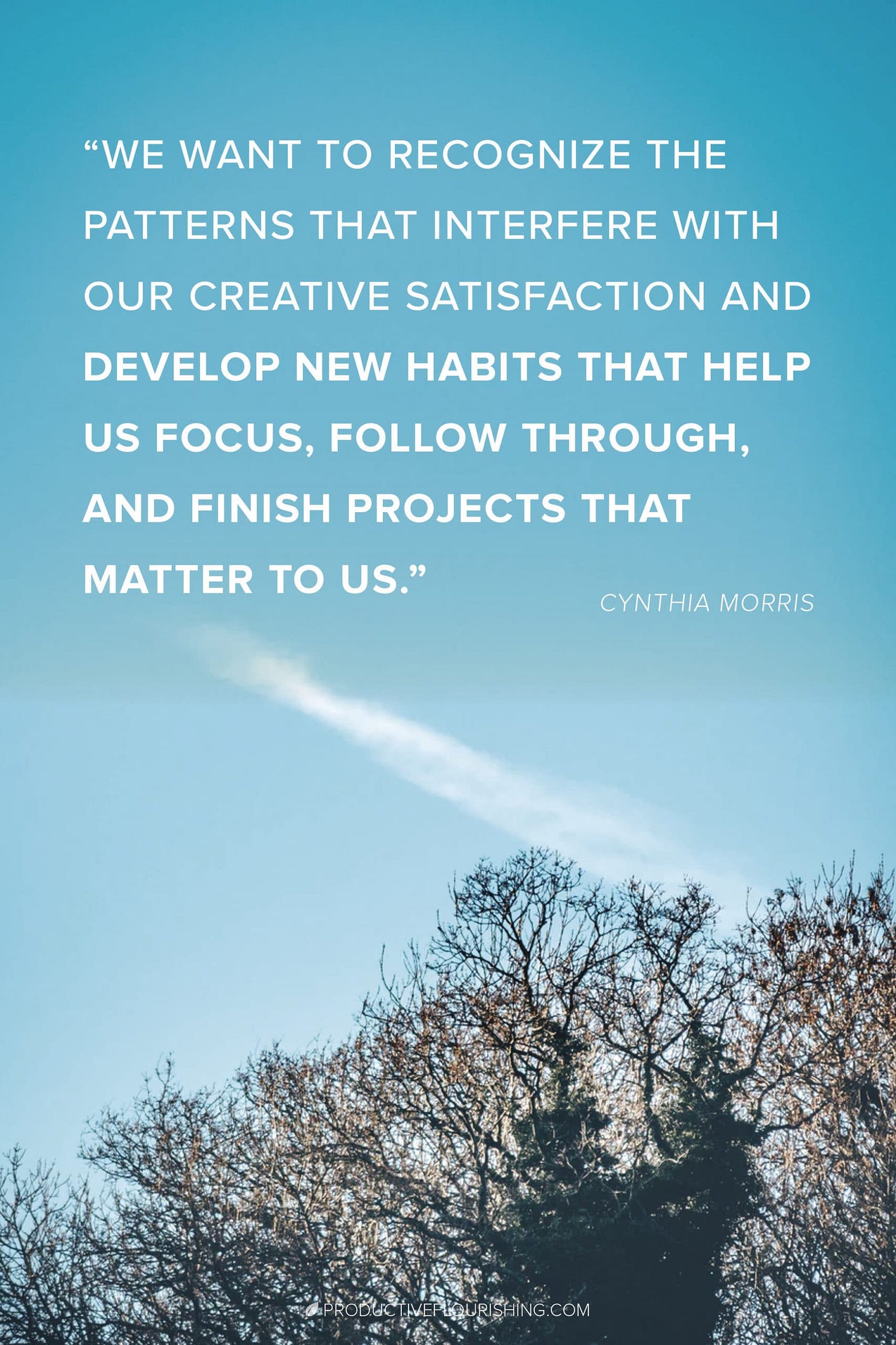5 Ways to Resist Bright Shiny Object Syndrome and Finish What You Start

Editor’s note: This is a guest post by Cynthia Morris.
There I was, working on final edits for my podcast writing. And then, it zoomed in — an idea for another project! Something I would love to do!
Next thing you know, I was jotting down ideas, playing with timelines, doing research…for something that would take place a year from now.
Does this ever happen to you?
You’re focused on a project and come to a sticky spot. A tough place. A part of the project that calls for more courage, more focus, and perhaps more help.
It’s tight in these spots. The kind of focus required to make a sentence sing isn’t always easy to attain. You are “on the spot” to produce something “good.” In that moment, inspiration may not be available. Yet you have to stay with it.
“Staying with it,” though, isn’t always our greatest strength.
Rather, that’s when new projects seem like a great idea.
A really, really great idea.
We pounce on that idea and start playing with it. It’s easier to explore the new project than to stick with the challenge we face in our current work.
The Funnel
Rather than beat ourselves up for succumbing to this Bright Shiny Object Syndrome, it might help to understand what’s at play.
I’ve developed a model that helps us visualize where we are in the creative process and why many of us have a hard time sticking with things. Creating this sort of visual can help us identify solutions for common obstacles.
I consider the creative process to be like a funnel.
At the top of the funnel, the space is wide. Possibility floats here. Every idea is a good one.
The middle of the funnel, where there’s still a lot of space, is where we are still in the phase of possibility. We are making decisions, but they are not the final ones.
The narrow, tube part of a funnel, is the place where we are choosing final details. It doesn’t always feel good to eliminate possibilities. It’s often daunting to trust ourselves to make final decisions. In the tube phase, we often have to ask for help to bring our project to light.

Possibility
As creative people, we thrive on possibility.
Have you ever met a creative person who doesn’t have a lot of ideas? Ideas are catnip to the creative person. We cherish our ideas.
They feel good!
We love the wide, open space in our imagination where anything can happen.
But there comes a time when we have to choose something to focus on. Because even though all those ideas seem sexy, in reality, books, bodies of art, and businesses don’t get made by hovering in idea mode forever.
So we commit to one idea. A book. A podcast. A body of artwork. A business offer.
It’s difficult to choose because all our ideas are precious to us. But finally, we commit because we are excited about this one idea.
We proceed down the funnel. Soon, the funnel narrows, and possibility evaporates.
We start to confront the challenges inherent in making good on that original vision. We face limitations of time, space, and skill level.
The reality is that our minds love complex ideas. But when it comes to executing on them, we usually need to simplify.
This happened when I was writing my novel. I had many difficult elements to balance. The novel was historical, based on a real person, and involved time travel. I was forced to simplify, to break the plot down, and to get a lot of help.
And, truth be told, I had no idea how to write a novel. I was learning as I went. This was humbling and uncomfortable. Other, easier projects tempted me to abandon the novel many times.
Perseverance
You may have experienced something similar with a different project.
Whenever we’re doing good work, we’re going to be confronted by our limitations.
All the fears we’ve been carrying for years rise up.
Almost everyone I have ever coached — including myself — has the same three fears.
Will it (we) be good enough?
Do we have what it takes to pull this off?
Will anyone care?
We don’t always like hearing or answering those questions.
So we start to squirm. We thrash.
This is when the new ideas sparkle brightly at the top of the funnel.
What if we…did that other thing instead? Oh, yes!
So we pop back to the top of the funnel and start a different project.
Sound familiar?
Training
This is when you become the person who moans, “I never finish anything.” That happens for a lot of reasons, but a primary one is training.
You haven’t trained yourself to endure the painful reality of your limitations.
When faced with your limitations, fears, and OMG panic mode, here are some strategies I and my clients have used to cope.
1. Remember why you must do this project.
Lots of ideas are good ones, but only a few are ones we absolutely must do.
What’s your unshakeable why?
Have this written down in one, simple rallying cry. Keep it front and center when you want to pop up to the top of the funnel.
2. Lower your expectations.
We often think that our first pass has to be as stellar as the vision of the project. We may start with that initial enthusiasm of the great idea.
But pretty quickly, the otherworldly genius of our vision is replaced by the all-too-human reality. The first version may not be stellar.
Most of the things we make require several drafts or versions. Letting go of perfection in the beginning will allow you to enjoy the process more.
3. Adjust the vision.
Sometimes the vision is bright and shiny from the get-go, but it doesn’t need to be that way for you to get started.
Almost every project I’ve seen morphs and shifts from its original form. That’s okay. That’s the partnership between you and whatever magic is the source of our inspiration.
How might you ratchet down the vision and still keep the essence of it?
Does it have to be a trilogy? Could it just be one novel?
Does it need to be a multi-modal course? Perhaps it’s just an initial webinar and not a weeks-long program.
It can be hard to let go of the vision, but I believe that a finished project is better than a partially-baked idea.
4. What’s to love?
It’s easy to love the initial, exciting part of the process. You’re getting your ideas onto paper, the screen, or an audio file.
But what’s there to love about the editing, feedback, or development part of your project?
Look for things that reflect your values.
For instance, your value of wordplay or curiosity might help you when you are in the editing phase. How can you make this sentence better? What words might work better here?
Look to ignite enthusiasm throughout all phases of the project, not just at the beginning.
5. Hold space for your great ideas.
What do you do when all those other ideas clamor for your attention like bored kids on a road trip the minute you settle down to embrace one project?
Two things can help. First, have an idea file where you log ideas for later reference. Second, use a timeline. Get clear on why the immediate project needs to happen now. Assign it a deadline. Then identify when the other projects will get their due.
Reality
All of those strategies sound completely rational, right?
But the truth is, the way we operate is far from rational. We continue to work on projects to halfway, even though we know that’s not satisfying.
Again and again, we allow new ideas to hijack our focus. The trick here is not to beat ourselves up. We’re only human.
Rather, we want to recognize the patterns that interfere with our creative satisfaction and develop new habits that help us focus, follow through, and finish projects that matter to us. (Tweet this.)
As I write this, I am in the middle of this cycle. My current project is a series of essays that are calling me to write in new, vulnerable ways.
I’m in the editing phase, where the rubber meets the road. I have to focus hard to polish the work, but a compelling idea for next year has bloomed on my mental horizon. Oh, joy! I switch gears to make notes and flesh out the dream. Another project I will start in January also feels a lot more exciting.
When those thoughts arise, I slow down. I recognize that I am approaching the tube part of the funnel, the part where I prepare the work for publication, the part that is not glamorous or sexy or even all that fun.
I bring compassion to myself and remember I’m human, with a limited amount of time, space, and skill. Then I give a small amount of time and attention to those other projects. If I don’t, they’ll only distract or be forgotten.
Then I bring myself back to the editing work.
I’ve written eight books, completed and sold bodies of art, and developed and launched many writing and creativity programs. Throughout all of this, I have learned to know, like, and trust my process.
When I am tempted to pop to the top of the funnel, I know how to keep myself focused. This is what I guide my clients to experience — a deep trust in themselves. It’s not that they won’t be tempted by other ideas. It’s that they will know how to manage the impulse to flit around endlessly and start finishing more things.
How about you? What helps you resist Bright Shiny Object Syndrome, manage all your ideas, and focus on finishing them?
Interested in more ways to help you start finishing your projects? Check out Charlie's new book, Start Finishing, for practical ways to help you push your idea to done.





